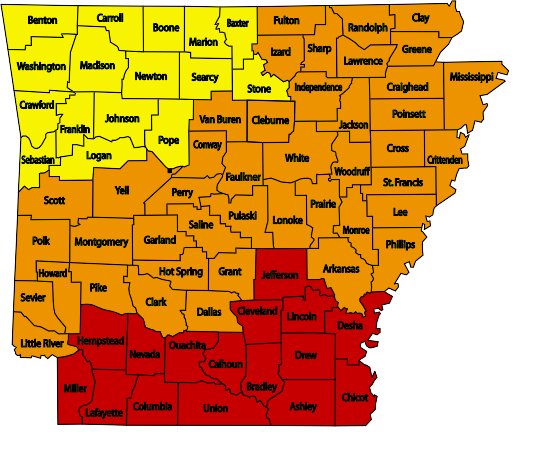By Mary Hightower
U of A System Division of Agriculture
LITTLE ROCK — With most of Arkansas at high risk of wildfires, state officials are asking the public to avoid outdoor burning.
On Thursday, the Arkansas wildfire map showed 64 counties at high risk, with 11 counties, all in northeastern Arkansas, at moderate risk. County judges have imposed burn bans in most of the high-risk counties.
Wildfire Danger & Burn Bans as of 10/21/2024 4:21 PM
According to the U.S. Drought Monitor’s Oct 21 map, almost two-thirds of the state’s 75 counties are experiencing moderate to extreme drought. The most intense drought is in five northwest Arkansas counties.
“This weekend kicks off the traditional gun deer season across Arkansas and many people will be traveling to deer camp,” Jaret Rushing, extension forestry instructor for the University of Arkansas System Division of Agriculture, said Wednesday. “Deer camp usually consists of campfires, so it’s important that people keep in mind the danger.”
Among the outdoor burning activities to avoid include:
Burning trash
Open flame grilling
Prescribed burns
Campfires.
Sparks from lawn mower blades, trailer safety chains, hot exhaust pipes and driving on a flat tire can also start a wildfire.
Wildfire Danger & Burn Bans as of 10/21/2024 4:21 PM
Risk levels are determined by fuel conditions, drought status, and long-term weather forecasts. They are categorized by how easily fires can start and how hard they are to contain. The risk level definitions are:
Low: Fuels do not ignite easily. Weather conditions will lead to slow spread and relatively easy to control fires.
Moderate: Fire can start from accidental causes. May not become serious, but caution should be taken.
High: Fires ignite easily and spread quickly. Unattended brush fires and campfires are likely to escape. Fires may become serious if not attacked early.
Extreme: Fires start quickly, spread furiously, and burn intensely. Every fire started has the potential to become large. Expect extreme, erratic behavior.
The Arkansas Department of Agriculture, which oversees protection of more than 15 million acres of forestland in Arkansas, said that since Oct. 1, it has suppressed more than 100 wildfires on 1,116 acres. Since the beginning of the year, more than 700 wildfires have burned 15,000 acres in Arkansas.
The department urged anyone involved in outdoor activities to carry water and extinguish sparks from muzzleloader guns or machinery.
Jacob Hackman, extension forestry specialist for the Division of Agriculture, said starting a fire could be expensive.
"You may be liable for damages caused by an escaped forest fire,” he said.
To learn about extension programs in Arkansas, contact your local Cooperative Extension Service agent or visit www.uaex.uada.edu. Follow us on X and Instagram at @AR_Extension. To learn more about Division of Agriculture research, visit the Arkansas Agricultural Experiment Station website: https://aaes.uada.edu. Follow on X at @ArkAgResearch. To learn more about the Division of Agriculture, visit https://uada.edu/. Follow us on X at @AgInArk.








